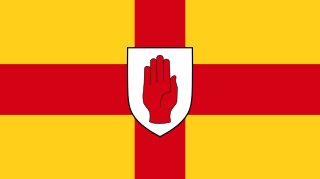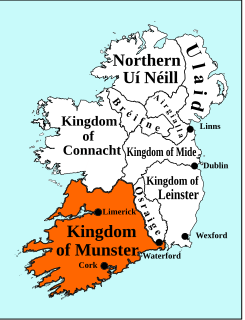Íar mac Dedad (Íar, son of Deda mac Sin) was a legendary King of Munster. He is the father, or in some sources more distant ancestor, of Eterscél Mór, and grandfather (or great-grandfather) of the famous Conaire Mór, both High Kings of Ireland.
Deda mac Sin was a prehistoric king of the Érainn of Ireland, possibly of the 1st century BC. Variant forms or spellings include Dedu, Dedad, and Dega. He is the eponymous ancestor of the Clanna Dedad, and may also have been a King of Munster.
Eterscél Mór, son of Íar mac Dedad, a descendant of Óengus Tuirmech Temrach, of the Érainn of Munster was, according to medieval Irish legend and historical tradition, a High King of Ireland. He succeeded Eochu Airem.
Conaire Mór, son of Eterscél, was, according to medieval Irish legend and historical tradition, a High King of Ireland. His mother was Mess Búachalla, who was either the daughter of Eochu Feidlech and Étaín, or of Eochu Airem and his daughter by Étaín. In the Old Irish saga Togail Bruidne Dá Derga he is conceived when his mother is visited by an unknown man who flies in her skylight in the form of a bird, and is brought up as Eterscél's son.
Íar may be the eponymous ancestor of the Érainn of Munster. Both the personal name and tribal name derive from the same root. [1] Among his historical descendants, through the later High King Conaire Cóem, are the Dál Riata of Ulster and Scotland, and the Corcu Duibne, Múscraige, and Corcu Baiscind of Munster. These were known as the Síl Conairi, one of the principal royal septs of the Érainn. [2]
Conaire Cóem, son of Mug Láma, son of Coirpre Crou-Chend, son of Coirpre Firmaora, son of Conaire Mór, was, according to medieval Irish legend and historical tradition, the 111th High King of Ireland. He came to power on the death of his father-in-law Conn Cétchathach, and ruled for seven or eight years, at the end of which he was killed by Nemed, son of Sroibcenn, in the battle of Gruitine. He was succeeded by Conn's son Art.

Dál Riata or Dál Riada was a Gaelic overkingdom that included parts of western Scotland and northeastern Ireland, on each side of the North Channel. At its height in the late 6th and early 7th centuries, it encompassed roughly what is now Argyll in Scotland and part of County Antrim in the Irish province of Ulster.

Ulster is a province in the north of the island of Ireland. It is made up of nine counties, six of which are in Northern Ireland and three of which are in the Republic of Ireland. It is the second largest and second most populous of Ireland's four provinces, with Belfast being its biggest city. Unlike the other provinces, Ulster has a high percentage of Protestants, making up almost half of its population. English is the main language and Ulster English the main dialect. A minority also speak Irish, and there are Gaeltacht in southern Londonderry, the Gaeltacht Quarter of Belfast and in Donegal, where 25% of the total Gaeltacht population of Ireland is located. Lough Neagh, in the east, is the largest lake in the British Isles, while Lough Erne in the west is one of its largest lake networks. The main mountain ranges are the Mournes, Sperrins, Croaghgorms and Derryveagh Mountains.
The brother of Íar was Dáire mac Dedad, eponymous ancestor of the Dáirine. He succeeded Íar as king of Munster. [2]
Dáire mac Dedad is the eponymous ancestor of the Dáirine of Munster and father of the legendary Cú Roí mac Dáire. These further associate him with the prehistoric Darini of Ulster. He is probably identical with Dáire Doimthech (Sírchrechtach), an ancestor of the Corcu Loígde. As such he is a common ancestor of several prominent dynasties of the so-called Érainn, including the Dál Fiatach of Ulster.
The Dáirine, later known dynastically as the Corcu Loígde, were the proto-historical rulers of Munster before the rise of the Eóganachta in the 7th century AD. They appear to have derived from the Darini of Ptolemy and to have been related to the Ulaid and Dál Riata of Ulster and Scotland. In support of this, their ancestors appear frequently in the Ulster Cycle, where they are known as the Clanna Dedad, and are the killers of Cú Chulainn. All are considered Érainn. In historical times the Dáirine were represented, as stated, by the Corcu Loígde, and probably by the Uí Fidgenti and Uí Liatháin, as well as a few other early historical kindreds of both Munster and Ulster. In ancient genealogical schemes, the historical Dál Fiatach of Ulaid also belong to the Dáirine.






